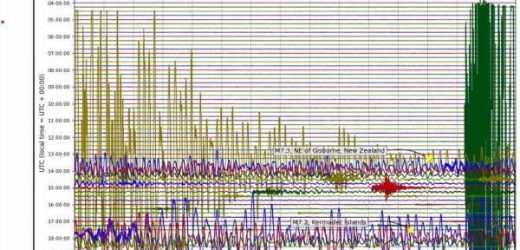The government’s emergency response body is defending a decision to not send out a widespread mobile phone alert, saying only those living in the path of a potential tsunami needed warning.
After a frightening start to the day, there’s concern residents in the path of the potential tsunami on the eastern coastline did not get alerts on their phones or hear sirens warning them of the looming danger.
Civil Defence in quake-affected North Island regions are also coming under fire for posting confusing messages to people looking for direction immediately after this morning’s severe 7.1 tremor struck off the east coast of the North Island at 2.27am.
But National Emergency Management Agency communications manager Anthony Frith said emergency mobile alerts were sent out and were geographically targeted to specific areas where there was a land threat of potential flooding in place.
That meant today’s alert was sent to areas where people needed to evacuate, said Frith.
“We only issue emergency mobile alerts to those areas because we don’t need to wake people up in the middle of the night for a beach and marine advisory.”
He said people in beachside settlements of Papamoa or Opotiki did not get the warningbecause there was no need for residents to seek safety.
“If you didn’t get anemergency mobile alert chances are you weren’t in the affected area,” he said.
The early morning alert was broadcast on mobile phones from East Cape to Tologa Bay.
“If people were in the area with mobile coverage and they had a compatible phone and live in that area they should have got it.”
He praised people for taking initiative and going to higher ground after the long and strong quake.
He said while the NEMA issued tsunami alerts, it was the local civil defence who would issue locally explicit evacuation advice.
“We have evergreen advice that if you feel a long and strong earthquake go as far inland as possible or to higher ground because we will not be able to issue a warning before the first waves hit in a locally-generated tsunami.
“It may turn out there is no tsunami but the advice we give it’s better to be safe than sorry.
“If people evacuated when they felt the natural warning signs they did the right thing,” said Frith.
He said it was up to local civil defence to activate tsunami sirens.
One Hawke’s Bay resident said the local Civil Defence Facebook page noted the quake in a post but said it was unlikely to pose a tsunami threat.
That led to many locals expressing frustration – with people referring to government messaging that if a quake is long or strong get gone.
Up to 30 minutes later the post was edited to match the national Civil Defence advice to take refuge on higher ground if you were in coastal communities.
“If there had of been a tsunami most folk in red zone would have been up the creek without a paddle,” said the concerned resident who had experienced the deadly Christchurch earthquake 10 years ago.
From experience she didn’t wait for public advice, but instead put her children in the car and “got going”.
Bay of Plenty Civil Defence confirmed an emergency mobile alert had been issued by the national agency warning of coastal flooding in the east coast of the North Island from the east of Cape Runaway to Tolaga Bay.
But not everyone in the tsunami zone reported getting the alert – and others in the South Island got up to 17 warnings.
A Tolaga Bay resident said he did not receive any emergency texts or tsunami alerts this morning.
He said while there were social media posts on Twitter and Facebook from local civil defence about the need to evacuate, a lot of elderly people in the region did not have access to this technology.
“We need alarms. We need coastal tsunami alert systems that go off,” he told NewstalkZB’s Bruce Russell.
Scared families had taken refuge up a nearby hill.
A person living in the South Island reported getting up to 17 alerts on an iPhone.
Frith said anyone who got multiple messages outside the affected area were likely to have signed up to unofficial apps.
According to the NEMA website emergency mobile alerts are messages about emergencies sent by authorised emergency agencies to capable mobile phones.
The alerts can be targeted to areas affected by serious hazards and will only be sent when there is a serious threat to life, health or property, and, in some cases, for test purposes.
Source: Read Full Article


